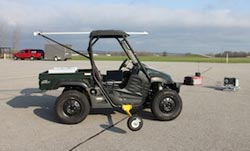Motion Control Keeps Electric Car’s Four Wheels—and Four Motors—on the Road

An experimental electric car under development at Ohio State University. Photo by Junmin Wang, Courtesy of Ohio State University.<br>
With four wheels that turn independently, each with its own built-in electric motor and set of batteries, the experimental car is the only one of its kind outside of commercial carmakers’ laboratories.
“It is considered one of the promising future vehicle architectures,” said Junmin Wang, assistant professor of mechanical engineering and Director of the Vehicle Systems and Control Laboratory at Ohio State. “It would make a good in-city car—efficient and maneuverable, with no emissions. Our task is to make a robust control system to keep it safe and reliable.”
In a paper in the January 2013 issue of the journal Control Engineering Practice, his team described the car’s ability to follow a specific trajectory.
In tests on good road conditions at the Transportation Research Center in East Liberty, Ohio, the car followed a driver’s desired path within four inches (10 cm). To test slippery road conditions, the researchers took the car to an empty west campus parking lot on a snowy day. There, the car maneuvered with an accuracy of up to eight inches (20 cm), and the vehicle traction and motion control system prevented “fishtailing” through independent control of the left and right sides of the car.
Wang characterized these results as more accurate than a conventional car, though the comparison is hard to make, given that conventional cars are much more limited in maneuverability by the transmission and differential systems that link the wheels together mechanically. The four independent wheels of the electric car give drivers greater control and more freedom of movement.
The experimental car also weighs half as much as a conventional car—only 800 kg, or a little over 1,750 pounds—because it contains no engine, no transmission, and no differential. The researchers took a commercially available sport utility vehicle chassis and removed all those parts, and added a 7.5 kW electric motor to each wheel and a 15 kW lithium-ion battery pack. A single electrical cable connects the motors to a central computer.
One hundred times a second, the onboard computer samples input data from the steering wheel, gas pedal and brake and calculates how each wheel should respond. Because the wheels are independent, one or more can brake while the others accelerate, providing enhanced traction and motion control.
In fact, a driver who is accustomed to conventional cars would have a difficult time driving a car of this experimental design, known as a “four-wheel independently actuated” (FIWA) car without the help of the vehicle motion and traction control system. With its ability to turn sharply and change direction very quickly, the car could be hard to control. Wang has tried it.
“Without the controller, it’s very hard to drive. With the controller, it’s quite nice—quiet, and better control than commercial four-wheel drive,” he said.
The main challenge for his team—which consists of bachelor’s, master’s, and doctoral students as well as a few local high school students—is to make the whole traction and motion control system energy-efficient and fault-tolerant, so if one wheel, motor or brake malfunctions, the others can compensate for it and maintain safety. It’s a situation analogous to a multi-engine plane losing an engine: the other engines have to adjust thrust and angle to keep the plane safe and on course.
Future work will concern the FIWA car’s energy efficiency for increasing its travel range in urban environments, and optimizing the weight distribution in the car.
Wang estimates that we won’t see a FIWA car on the road for another 5-10 years, as researchers continue to develop new algorithms to control the car more efficiently and add more safety features.
The coauthor on the paper was Rongrong Wang, a doctoral student in mechanical engineering, and the team’s high school participants came from the Columbus Metro School, a state of Ohio public STEM (science, technology, engineering, math) high school open to students from around the state.
This research was supported by Junmin Wang’s awards from the Office of Naval Research Young Investigator Program (2009) and the National Science Foundation’s Faculty Early Career Development Program (2012); the Honda-OSU Partnership program; and the OSU Transportation Research Endowment Program.
Contact: Junmin Wang, (614) 247-7275; Wang.1381@osu.edu
Written by Pam Frost Gorder, (614) 292-9475; Gorder.1@osu.edu
Editor’s note: a photograph of the experimental FIWA car is available from Pam Frost Gorder.
Media Contact
More Information:
http://www.osu.eduAll latest news from the category: Automotive Engineering
Automotive Engineering highlights issues related to automobile manufacturing – including vehicle parts and accessories – and the environmental impact and safety of automotive products, production facilities and manufacturing processes.
innovations-report offers stimulating reports and articles on a variety of topics ranging from automobile fuel cells, hybrid technologies, energy saving vehicles and carbon particle filters to engine and brake technologies, driving safety and assistance systems.
Newest articles

Parallel Paths: Understanding Malaria Resistance in Chimpanzees and Humans
The closest relatives of humans adapt genetically to habitats and infections Survival of the Fittest: Genetic Adaptations Uncovered in Chimpanzees Görlitz, 10.01.2025. Chimpanzees have genetic adaptations that help them survive…

You are What You Eat—Stanford Study Links Fiber to Anti-Cancer Gene Modulation
The Fiber Gap: A Growing Concern in American Diets Fiber is well known to be an important part of a healthy diet, yet less than 10% of Americans eat the minimum recommended…

Trust Your Gut—RNA-Protein Discovery for Better Immunity
HIRI researchers uncover control mechanisms of polysaccharide utilization in Bacteroides thetaiotaomicron. Researchers at the Helmholtz Institute for RNA-based Infection Research (HIRI) and the Julius-Maximilians-Universität (JMU) in Würzburg have identified a…



